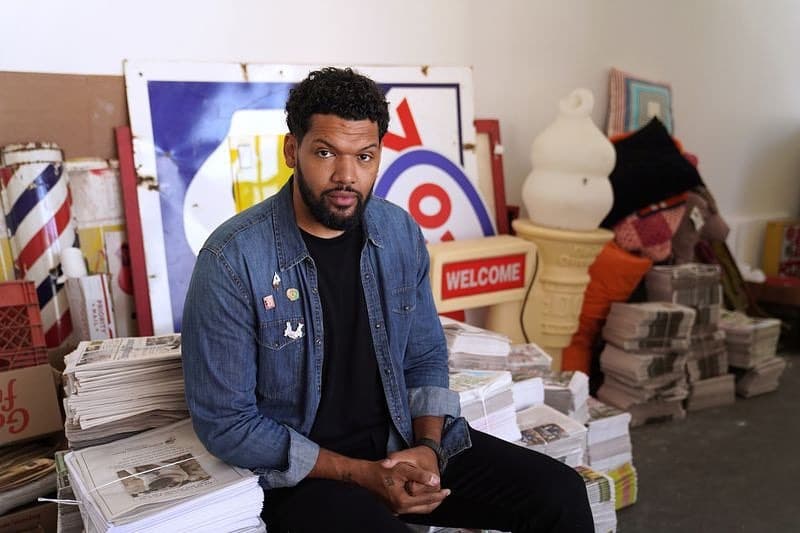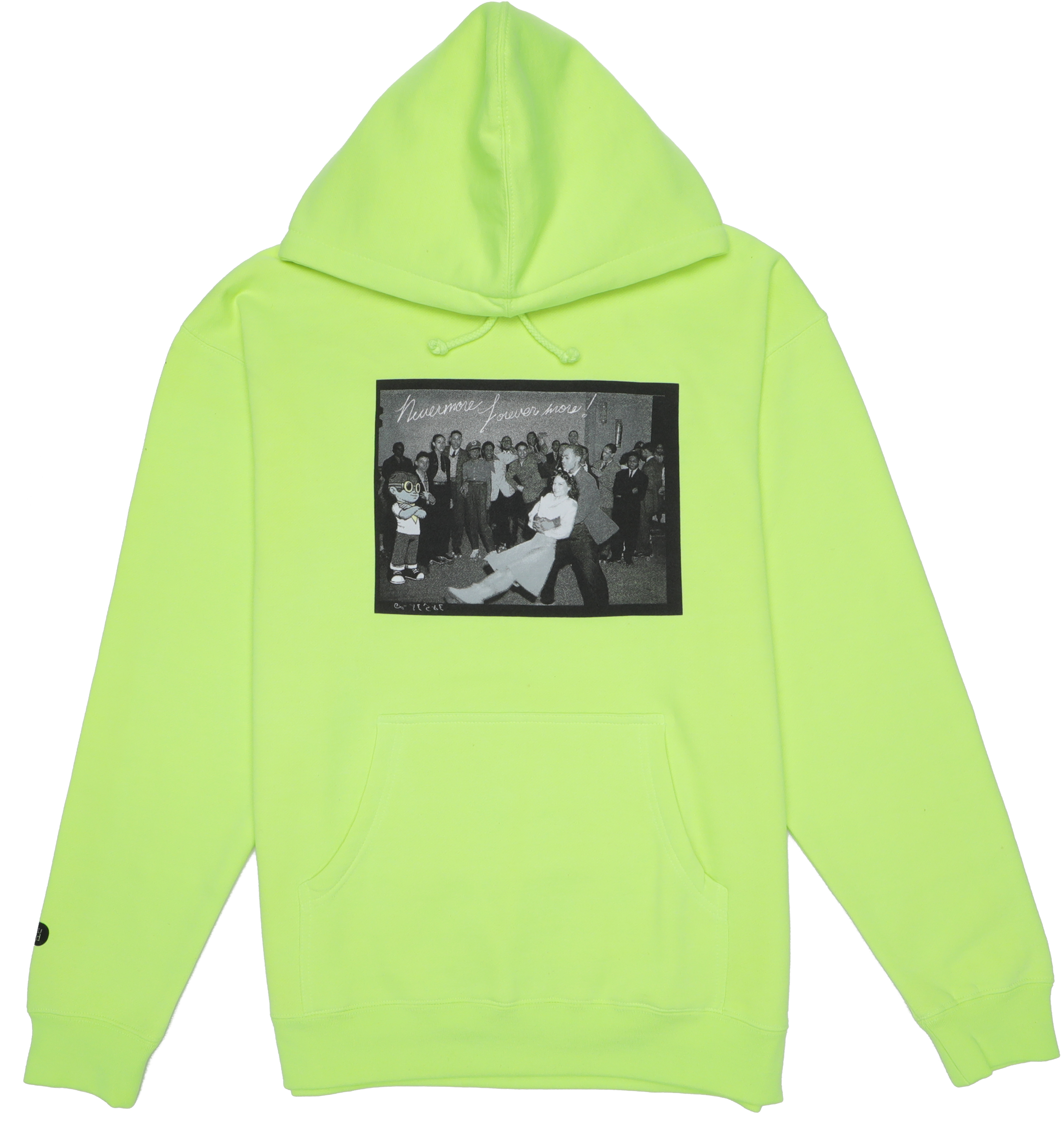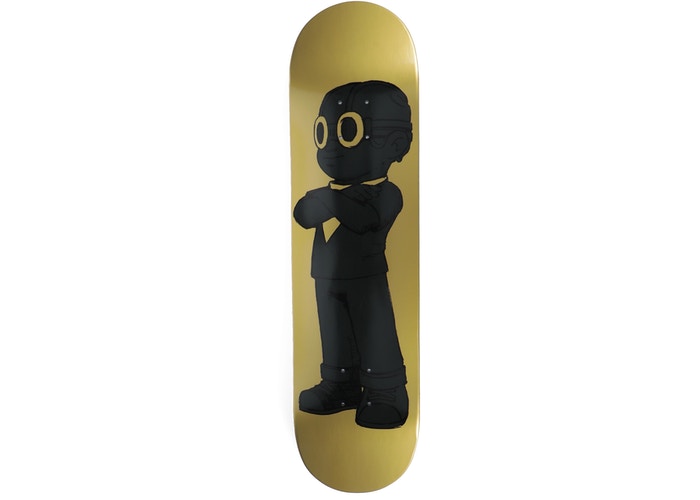Everyone has their own great debate, a question that sets the path for vision and action. But for many of us, 2020 has forced a change or refocus on what that central debate might be. The events of this year have acted as a universal challenge to inspect and explore the need for growth and experience, pushing us in new and unexpected directions. At StockX, we have partnered up with Hebru Brand Studios and Hebru Brantley to release three unique pieces as a part of The Great Debate collection. A hoodie, t-shirt, and skate deck, each featuring Brantley’s famous Flyboy and a central message about empathy and courage, will be made available exclusively to StockX customers in limited numbers. We caught up with Brantley to discuss his inspiration, the project’s development, and what we all need to see more of.
StockX: Tell us a little bit about Flyboy: what is the story of his inception and how has he evolved over time?
Hebru Brantley: The Flyboy came about through trial and error – accidentally actually – through my painting, trying to figure out my voice and what I was saying. I think the best advice I got from a lot of my contemporaries was that the work I was doing was okay, but it didn’t reflect me. I needed to paint more of what I knew. What I felt like I knew better than anything was the world of animation, storytelling, cartoons, comics, et cetera. I arrived at Flyboy accidentally while reading a book on World War II – finding out about the Tuskeegee Airmen. The rest is history.
When we talk about armed conflicts with American history, it’s so whitewashed. How much of your work do you see as educational versus representative? Do those conflict or do they work together?
I think representative is educational. There is no time better than right now; the mission is to educate folks. You look at what’s happening right now in the political landscape and Black Lives Matter and the struggle, you know. It’s about educating people about the injustices in the world. There is a tremendous amount of inequality. I think for me with my work, my work is personal, it’s human – in terms of being a reflection of how I feel and respond to society at large. I think that there is some universality to that as opposed to just being one-sided or it being completely from the black African-American perspective. There are things that happen to all of us, there are things we endure, things we all go through – moments, feelings that we all share in some way, shape, or form that make us human and connect us that I infuse in my work. It’s always ever-present in all that I do.
As a part of that representation, so much of the conversation that we have had this year has been about grief and pain. You’ve chosen this very specific image for these pieces that’s a representation of Black joy. Why do you think it’s so important for our community to see a representation like that?
It’s sort of the adverse of what is put out there. I think that there is still, and always will be, a great deal of stigma around black folks, especially black males. There is a lack of that vantage or viewpoint. We as humans, we as consumers, we as Americans tend to navigate closer to the negative most times. For me, sometimes it can be a forced smile. Not to say that it’s the actual image on a piece, but that’s the mentality. It’s trying to find hope in hopelessness. Thinking through the idea of empowerment over power and having the work embody some of those notions and more.
We need more positive representation. We just need it.
I have pieces that kind of run the gamut as far as mood and emotion. But I think that there is something that is potentially captivating to certain audiences when it comes to these characters. It instills a sense of hope and joy. It’s an empowering image. It has grown to an iconic level if you will. Obviously, that sounds far more arrogant than I intend it to, but I think that has been the overall consensus for people that view my work. The feelings that overtake them initially are those feelings of joy, hope, empowerment, and things of that nature. If that’s what it is, then great. That’s phenomenal – it’s not an easy feat.

In the piece that is on the t-shirt and the hoodie, Flyboy is within the context of that image. But then on the skate deck, he is by himself on a field of gold. Is that in the same conversation? Is it doing similar things?
Yes, it is. The original piece for that image comes from a series I did last year and sort of worked into this year a bit called The Great Debate. The concept behind it is the oldest conversation that man has ever engaged in. It’s the perspective – and everybody has that perspective, especially right now where you have groups standing off, sounding off on their perspective on the way of the world – politics, racial inequality, social injustices, and so forth. It has a universality to it in a way that it will always be a conversation. This great debate between those groups that stand firm to their beliefs, in one shape, form, or fashion. I’m trying to articulate that visually with my character and his arms are crossed, unrelenting, unwavering like, “Nah, you aren’t going to change my mind.”
At the same time, there is something that allows for this character to be the observer within different settings. It’s almost like the quiet observer. You might feel one way, but that doesn’t mean you can’t learn from an opposing view or ideology. The intention of the piece in my mind is to continue to create that open dialogue about that perspective and the conversation, the Great Debate. Whatever that Great Debate is to the audience, everybody has their great debates. Whether it’s family, politics, race, whatever. This is very representative of the times.
What does “Nevermore Forever More” mean?
“Nevermore” for me leans into the notion of the greater world-building that I have done with Flyboy over the past couple of years. This idea of black excellence. I think about all that people of color have endured throughout the world, especially within the United States. Yet we continue to thrive, we continue to innovate, we continue to cultivate. It’s in that spirit to keep that up when we have been told that we can’t do these things, we shouldn’t do these things, what we are doing is wrong – that we are wrong. It’s shining light in very dark places, finding light in very dark places. It’s making the best out of a bad situation, but sort of holding that chant. I hate to come back and say it, but it’s empowerment over power.
You look at what’s happened now where I think people are realizing that you can’t change the world, but you can affect your community. That’s sort of a catalyst to changing the world. You can mushroom out from your community, but it starts there. That’s the mentality.
I come from Chicago. Chicago is an extremely segregated city. I grew up around mostly black people in an all-black neighborhood, a historically black neighborhood. I felt like for years growing up that the stories, the folklore, the legend of this place was not representative of where that place is now. I felt that even though we were together, we were divided. “Nevermore Forever More” is about finding unification within your own community. That’s where it’s got to start first. You have to build up your community, then you can start to spread out with that message. You can start to try to affect change elsewhere, but it starts within your base, within your means.
What is the message that you hope people receive from this project?
I don’t want to get too caught up in being too deep about a t-shirt, a skateboard, a hoodie.
I want people to feel good, I want them to feel empowered. Every little bit helps spread that message. Every person that sees it can connect with it and respond to it in certain ways. That’s on them. More than anything, what I set out to do with my work is to inspire. That’s the most important thing. It may sound corny or cliché, but it’s the truth. That’s what gets me up in the morning and fuels the tank – that I have the power, the capacity to inspire the next Hebru Brantley with something that I created on a whim or something that took me a year to do.
So given that 2020 is unique and every day is different, when do you find moments of peace of celebration for yourself? Where have you found inspiration or peace this year?
It’s been hard, but honestly, this marks a real turning point in some of the language and energy in my work. I feel like right now especially, I have a duty and a platform that I need to use to do a little bit more, just moving forward in general. That’s sort of the intention. I’ve never been one really hard-pressed for inspiration. I think it’s where you make it sometimes. Inspiration for me comes in many different forms. Right now, it’s my kids. I am inspired by the notion to be better for them, to continue my journey, my message for them. Because really, this shit isn’t about me anymore.
It’s like, how do we affect the next generation growing up so that they don’t have to go through shit like this? So that we can get closer to some form of eradication of all this bigotry, hate, and ugliness? Cats my age, if you a bigot, a racist, you made up your mind already and that’s going to be a hard sell to sway anybody. For me, it’s looking to them, looking to their purity, their innocence, and vibing off that, letting that guide some of my decision making from a creative standpoint.
The DropX with Hebru Brand Studios is set to go live on Thursday, November 12th at 12pm EST. Check back with StockX for access to all products.






